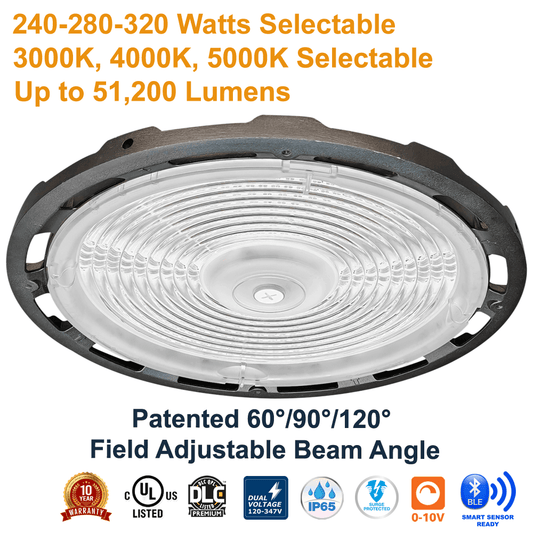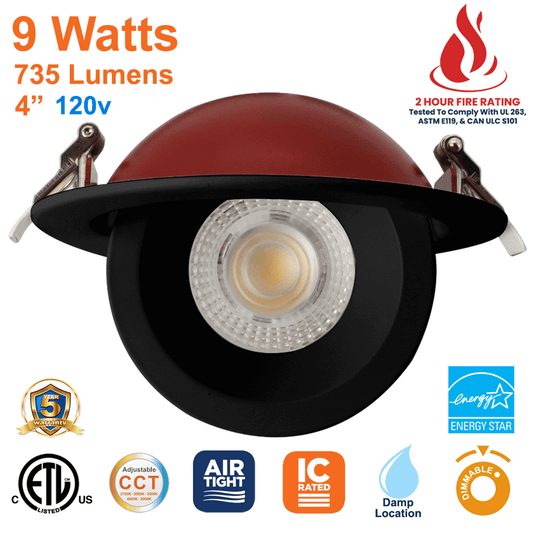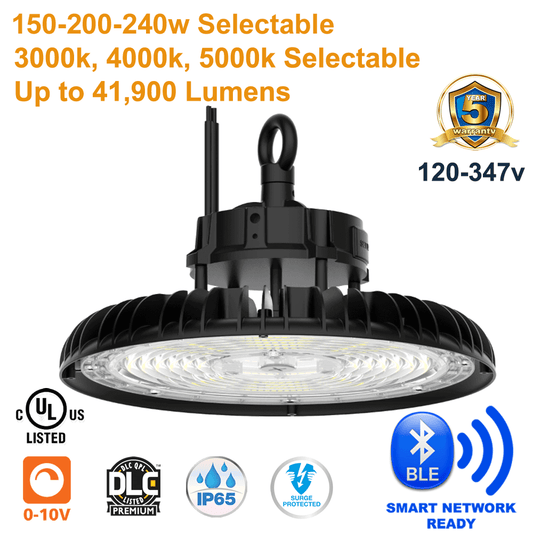From bustling warehouses to expansive factories, High Bay lighting holds a critical place in commercial and industrial setups. The quest for energy-efficient and cost-effective solutions has led to a noticeable shift towards High Bay LED Lights. With their enhanced longevity, superior luminosity, and drastic energy conservation, these lighting marvels are rapidly becoming the go-to choice for spaces with high ceilings.
In this article, we're going to explore the energy savings potential of LED High Bay Lights, answering the questions that often emerge when considering a High Bay Lighting upgrade. We'll also discuss the role of Networked Lighting Controls for High Bays and High Bay Occupancy Sensors in maximizing energy efficiency.
Unveiling the Power of LED High Bay Lighting
First things first, how much power do these LED luminaries actually use? High Bay LED Lights, despite their high-intensity output, are surprisingly energy-efficient. Typically, an LED High Bay Light uses between 100-300 watts of power. Compare this to traditional Bay Lights like Metal Halides that consume a whopping 1000 watts or more, and the energy savings potential is immediately apparent.
The reduced energy consumption of LED High Bay Lights is largely due to their superior efficiency in terms of lumens per watt. Lumens are a measure of the total light output, while watts measure energy use. A High Bay LED Light can typically produce around 130-150 Lumens per watt, nearly triple the efficiency of traditional lighting solutions. To gain a deeper understanding of this topic, we recommend you check out our blog post everything you need to know about Lumens.
More than Just Lighting: The Role of Networked Lighting Controls and Sensors
What if you could achieve even greater energy savings from your LED High Bays? Enter Networked Lighting Controls, an advanced technology that enables you to manage your lighting systems remotely and with increased precision. These controls allow you to adjust light output based on occupancy and natural light, group fixtures to work together, schedule lighting times, and even analyze energy usage data to further optimize your lighting setup.
One integral component of Networked Lighting Controls is the High Bay Occupancy Sensor. These sensors can detect when a space is vacant and automatically dim or switch off the lights, saving energy in the process. Not only do these sensors contribute to a substantial reduction in energy usage, but they also extend the lifespan of your LED High Bay Fixtures by reducing the amount of time they are left switched on unnecessarily.
LED High Bay Lights: A Comparison with Traditional Lighting
When compared to traditional High Bay Lighting options, the energy consumption of LED High Bay Lights is considerably lower. For instance, a typical 400 watt Metal Halide High Bay Light actually uses approximately 458 watts, including the ballast draw. In contrast, a comparable LED High Bay Light uses just 150 watts – a reduction of over 67%.
In the next part of this article, we'll take a further look into how LED High Bay Lights compare to other energy-saving light sources, such as Fluorescents. We'll also discuss the impact of external temperature on the electricity consumption of LED High Bay Lighting, and whether it's more cost-effective to leave the lights on or turn them off.
So, stay tuned to our blog as we continue to shed light on the impressive energy savings potential of LED High Bay Lights. From UFO LED Lights to High Bay Lighting Controls, we'll guide you through every facet of this innovative technology.
Is It More Cost-Effective to Leave LED High Bay Lights On or Off?
A common myth is that it's more energy-efficient to leave lights on rather than frequently switching them on and off. However, this doesn't hold true for High Bay LED Lights. While turning lights on and off can dramatically shorten the lifespan of some traditional light sources, LED High Bay Fixtures are largely unaffected by this. Therefore, the most energy-efficient practice is to switch off LED High Bay Lights when they are not in use, further emphasizing the usefulness of High Bay Occupancy Sensors and Networked Lighting Controls for High Bays.
How External Temperature Affects LED High Bay Electricity Consumption
Unlike many traditional light sources, LED Lighting performs exceptionally well under a wide range of temperatures. The performance and energy consumption of High Bay LED Lights remain remarkably consistent even in fluctuating external conditions. Moreover, they generate considerably less heat than traditional lights, reducing the load on cooling systems and contributing to additional energy savings. To understand more about how LEDs handle different conditions, our complete guide to LEDs can offer valuable insights.
LED High Bay Lights versus Energy-Saving Fluorescent Lights
Fluorescent lights have long been considered an energy-efficient alternative to traditional incandescent, halogen, and HID lights. However, when compared to an LED High Bay, they simply don't measure up. A typical fluorescent light emits around 50-100 lumens per watt, which is significantly lower than the 130-150 lumens per watt of LED High Bay Lights.
Moreover, High Bay LED Lights have a longer lifespan and require less maintenance than their fluorescent counterparts, leading to additional cost savings. For areas like Factories and Warehouses, the lower maintenance and replacement costs of LED High Bay Shop Lights can translate into substantial long-term savings.
As we continue this exploration in our next section, we'll look deeper into the various types of High Bay LED Lights, including the innovative UFO LED Lights. We'll also examine the applications of LED High Bay Lights in different commercial and industrial settings such as food processing and recreational facilities. So, stay tuned to discover more about the remarkable energy savings potential of High Bay LED Lights.
Discovering High Bay LED Lights Varieties and Applications
Understanding the unique benefits and applications of different types of LED High Bay Fixtures can help you choose the most suitable solution for your needs. Here, we turn our focus to the innovative UFO High Bay LED Lights. These lights offer superior illumination, a wide variety of beam angles, and are easy to install and maintain, making them ideal for spaces with high ceilings such as warehouses, factories, and large recreational facilities.
In fact, UFO LED Lights are transforming the way we light up the future, with their energy-efficiency and unparalleled durability. They are particularly effective in facilities with demanding conditions, like in Food Processing industries, where robust and waterproof lights are critical.
To ensure that these lights operate at optimal efficiency, incorporating Networked Lighting Controls is a smart decision. These systems provide granular control over lighting, allowing facilities to make real-time adjustments for maximum energy savings.
Wrapping Up
There's no question that the transition to High Bay LED Lights represents a significant opportunity for businesses to cut down on energy costs. By combining the high luminous efficacy of LED Lighting with the intelligent control of DLC Networked Lighting Control Systems, companies can dramatically reduce their energy consumption, all while enjoying superior illumination.
In short, energy savings from LED High Bay Lights, especially when combined with smart controls and sensors, can lead to considerable cost savings, improve operational efficiency, and contribute to sustainability goals. For a more detailed understanding of High Bay LED Lights and their potential, explore our various collections and informative blog posts available on The LED Network Blog.
Remember, every journey to energy efficiency and sustainability begins with a single step, and that step could very well be the switch to High Bay LED Lights.



























